Shrimp Pho Noodle Soup
This Shrimp Pho is a light and flavorful twist on the classic Vietnamese noodle soup. Packed with tender shrimp, aromatic herbs, and a fragrant broth, it’s the perfect meal for seafood lovers looking for a quick and easy version of pho.
In under 30 minutes, you’ll have a comforting, flavorful bowl of shrimp pho that’s perfect for lunch or dinner. Whether you’re craving a delicious homemade pho or seeking a lightened-up alternative to beef or chicken pho, this recipe will hit the spot.
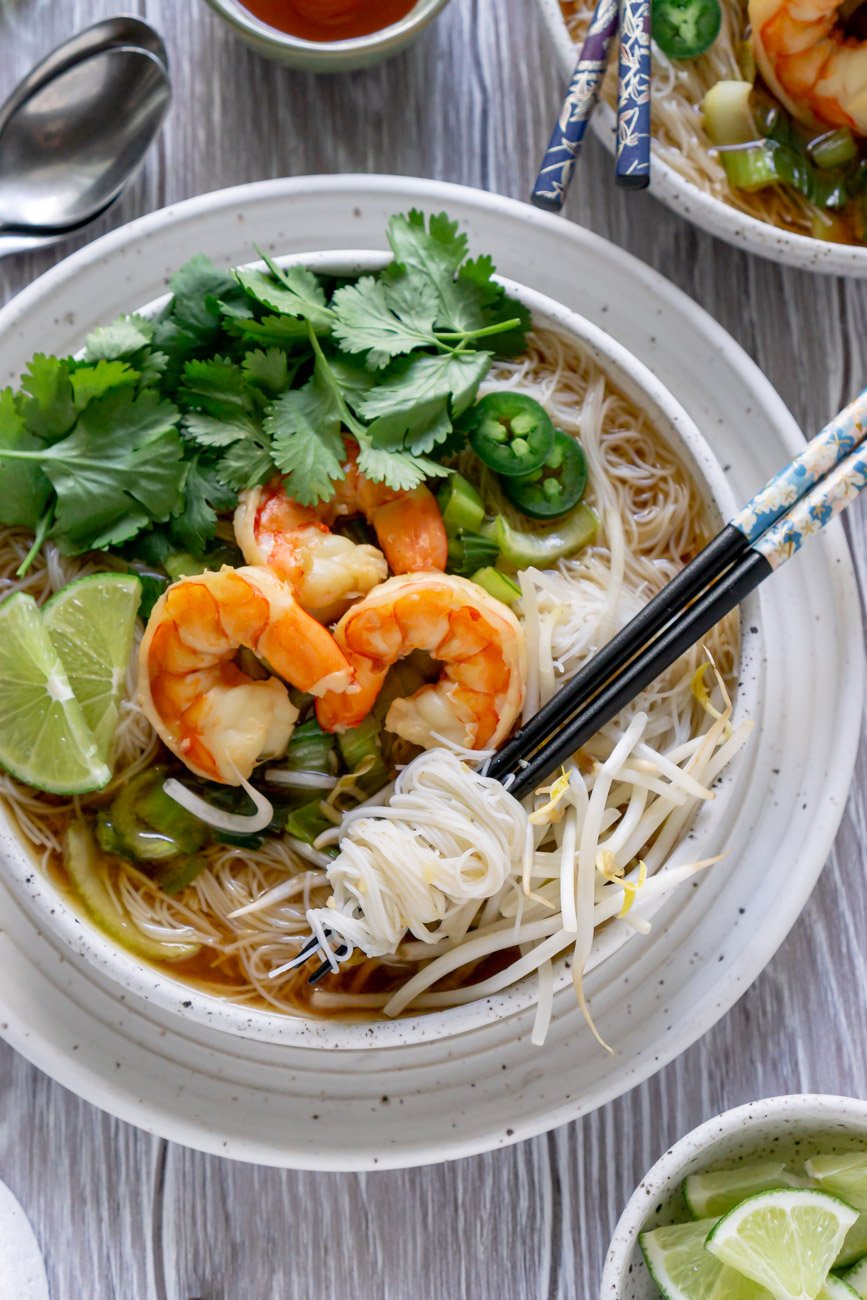
I looooooove this recipe for this pho!!! 😋😋 Not buying anymore pho for now on from no where else!!! This pho was perfect!! Thank you soooooooo much!!!
Looking to step outside the box? This recipe is perfect for leftover veggies. Cut up some mushrooms, cauliflower, etc. and toss them in to make a seafood and vegetable pho noodle soup.
If you are looking for a delicious Asian-inspired dinner from home, this pho recipe is perfect for you. This Shrimp Pho noodle soup provides that homemade comfort shining from its true star: the broth.
And for even more shrimp goodness, try my Bang Bang Shrimp Tacos or this simple Hibachi Shrimp!
Why This Recipe Works
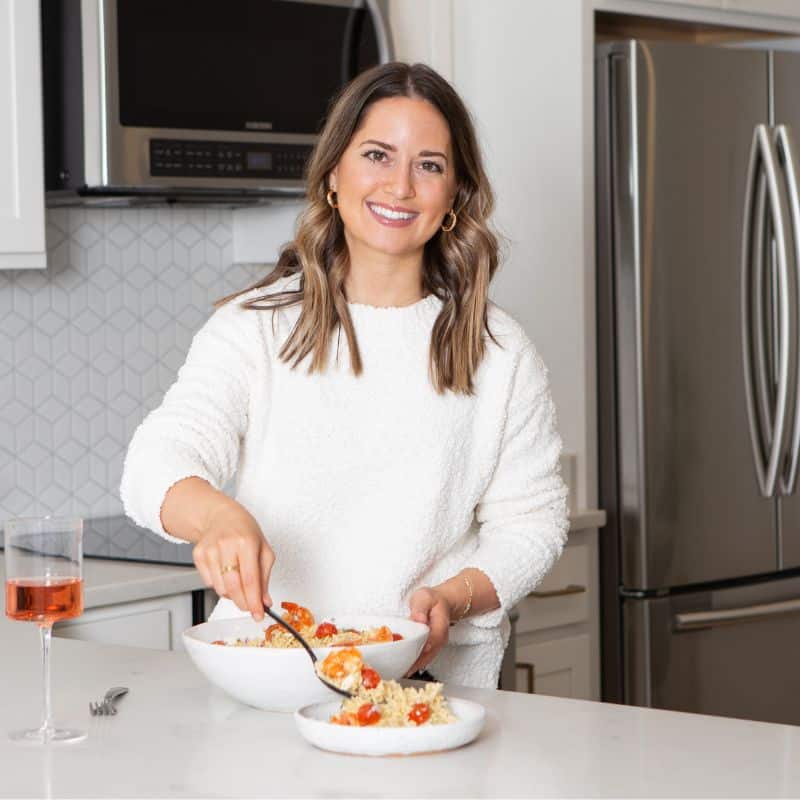
- Easy to make: Make this as a quick and beginner-friendly weeknight dinner made with simple ingredients, perfect for satisfying your pho cravings anytime, without having to simmer broth for hours.
- Great any time of year: Particularly good in the spring, this is also a nice hot soup that’s good for the fall and winter!
- Packed with Flavor: The aromatic broth, fresh herbs, and zesty lime bring out the authentic pho taste, while the shrimp adds a sweet and delicate flavor that complements the dish perfectly.
Ingredients You’ll Need
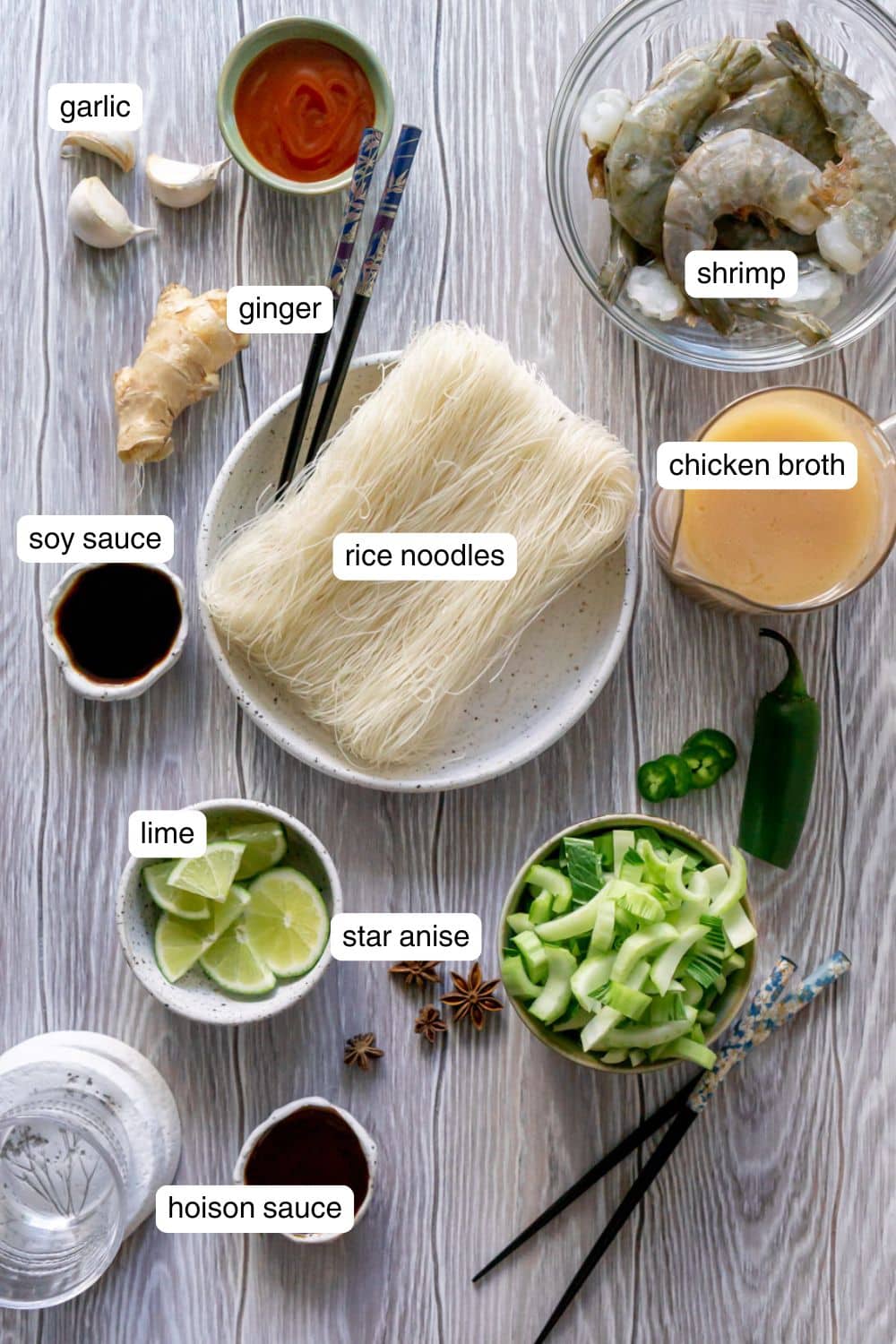
- Broth – I used chicken broth, but you can also use vegetable broth.
- Oil – bring out those incredible Asian flavors with sesame oil.
- Herb and spices – increase the delicious broth flavors with garlic, grated ginger (or ginger paste) and star anise.
- Sauces – to get the flavors just right you will need soy sauce, hoison sauce, fish sauce, and lime juice.
- Noodle – pho noodles are traditional but if you can’t get your hands on them, you can substitute with another thin rice noodle.
- Shrimp – for this recipe, I used jumbo shrimp, but if you’re looking for something bite sized, you can use smaller shrimp.
- Vegetables – I kept my recipe simple and only roughly chopped 2-3 heads of baby bok choy. If you feel like adding or have veggies that need to get eaten like mushrooms, cauliflower, etc. toss them in!
*For a detailed list of instructions, ingredients and measurements, please reference the recipe card down below.
Substitutions/Additions
- You can substitute chicken broth for bone broth and use coconut aminos instead of soy sauce if you are on a low-sodium diet.
- Feel free to omit the jalapeno for a less spicy soup.
How to Make Shrimp Pho
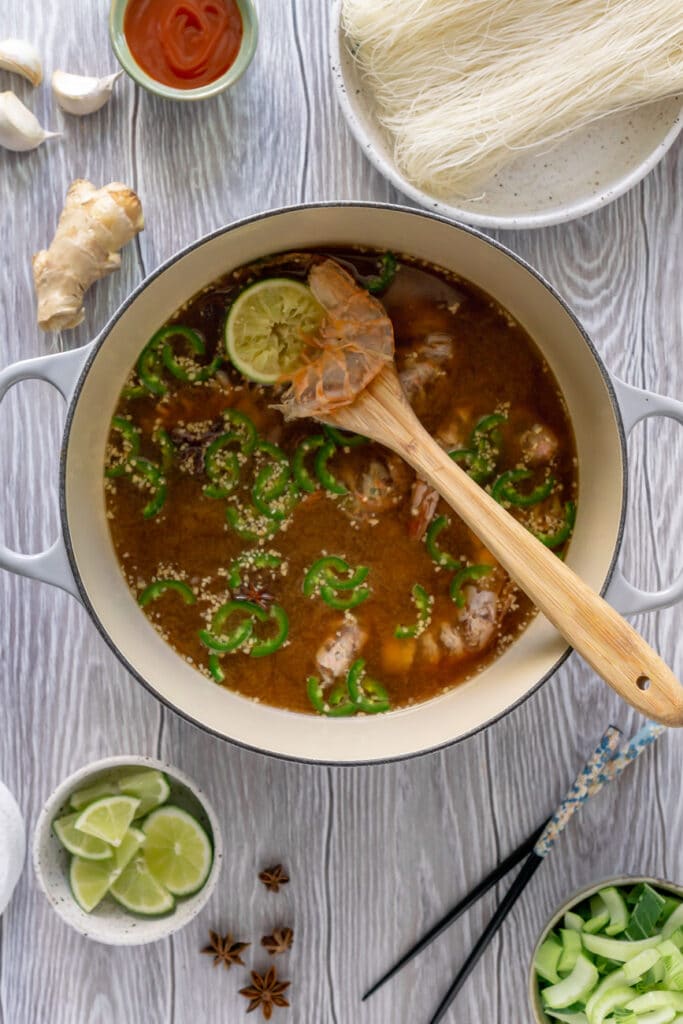
Step 1: Prepare broth. Remove shells from shrimp. Add sesame oil to a pot and cook garlic, ginger, and star anise until fragrant. Then add broth, shrimp shells, sauces, lime juice, and jalapeno. Bring to a boil then simmer for 20 minutes.
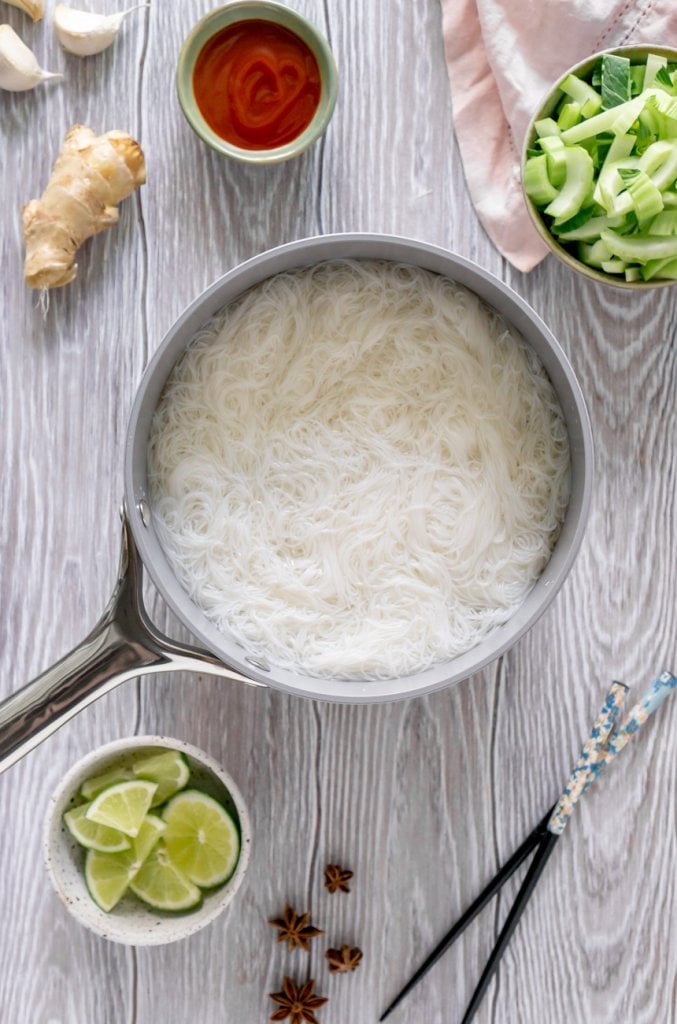
Step 2: Prepare noodles. Cook noodles according to package directions. Rinse with cold water to prevent overcooking.
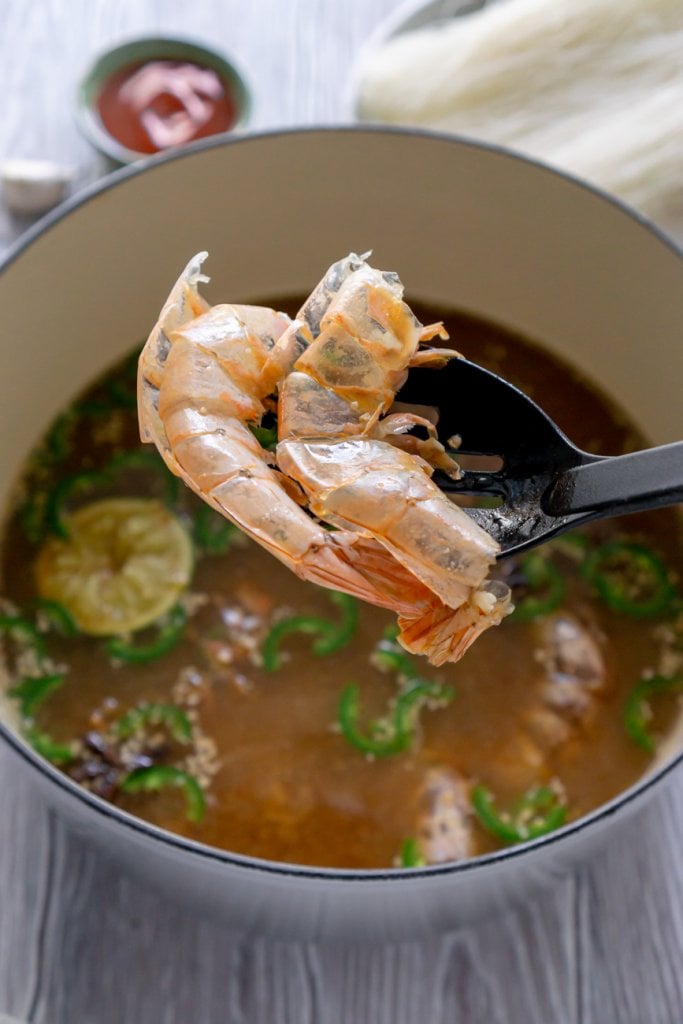
Step 3: Remove shells. Use a slotted spoon to take the shrimp shells out of the broth.
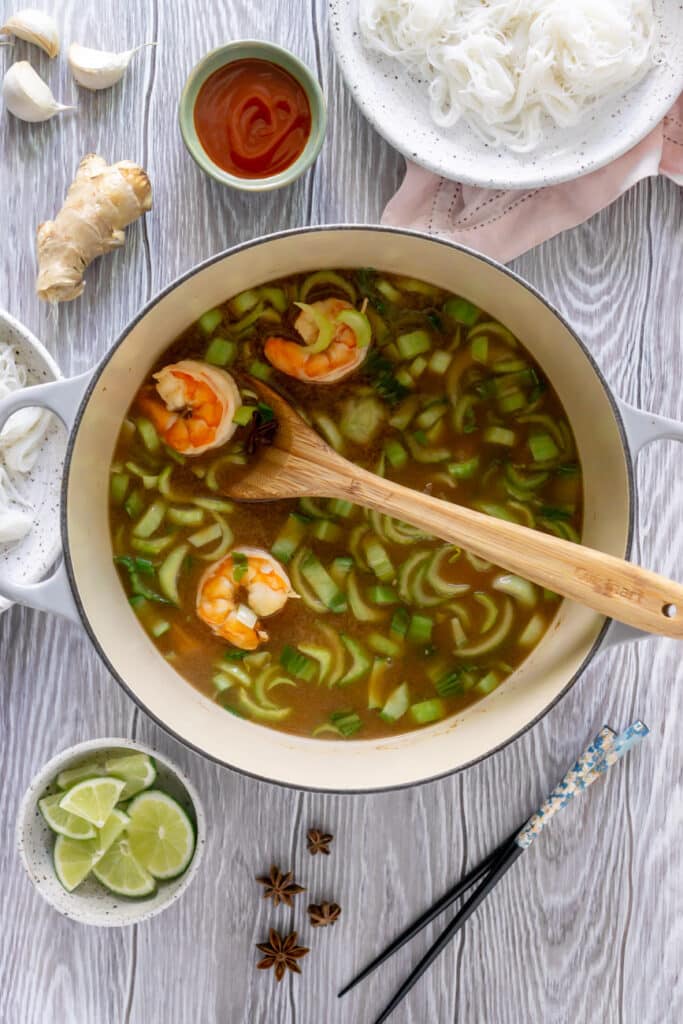
Step 4: Finish pho. Add bok choy and shrimp to the broth and cook until the shrimp is opaque and pink. Divide noodles between bowls and spoon broth over top.
Recipe FAQs
Traditional pho is deeply spiced, is incredibly aromatic, and takes about 6-10 hours to make. If you ever have time, I recommend trying a traditional pho recipe, it’s totally worth it! However, if you are looking for similarly great flavors (in less time) this seafood pho-inspired soup is a great substitute.
Overall, seafood pho can be healthy and a part of a well-balanced healthy diet. Seafood pho is loaded with nutritious ingredients like bok choy and bean sprouts and high in protein (from the shrimp). However, pho can also be high in sodium and calories (based on serving size).
I love making a little extra so I can have soup for lunch the next day! If you also have leftover rice noodles that have been soaked and/or cooked store them in a shallow airtight container, or a resealable plastic food bag, in the fridge. Your noodles will keep for 3-4 days, so don’t forget to eat them!
To reheat your leftovers, bring the broth to a boil and pour over the noodles.
Seafood Pho pairs wonderfully with fresh herbs like cilantro, basil, and mint. Add a squeeze of lime for brightness and some bean sprouts for a delicious crunch. You can also customize it with your favorite hot sauce or chili flakes for an extra kick of heat. Enjoy it with a side of crispy spring rolls or a refreshing Cucumber Salad to complete your Vietnamese inspired meal!
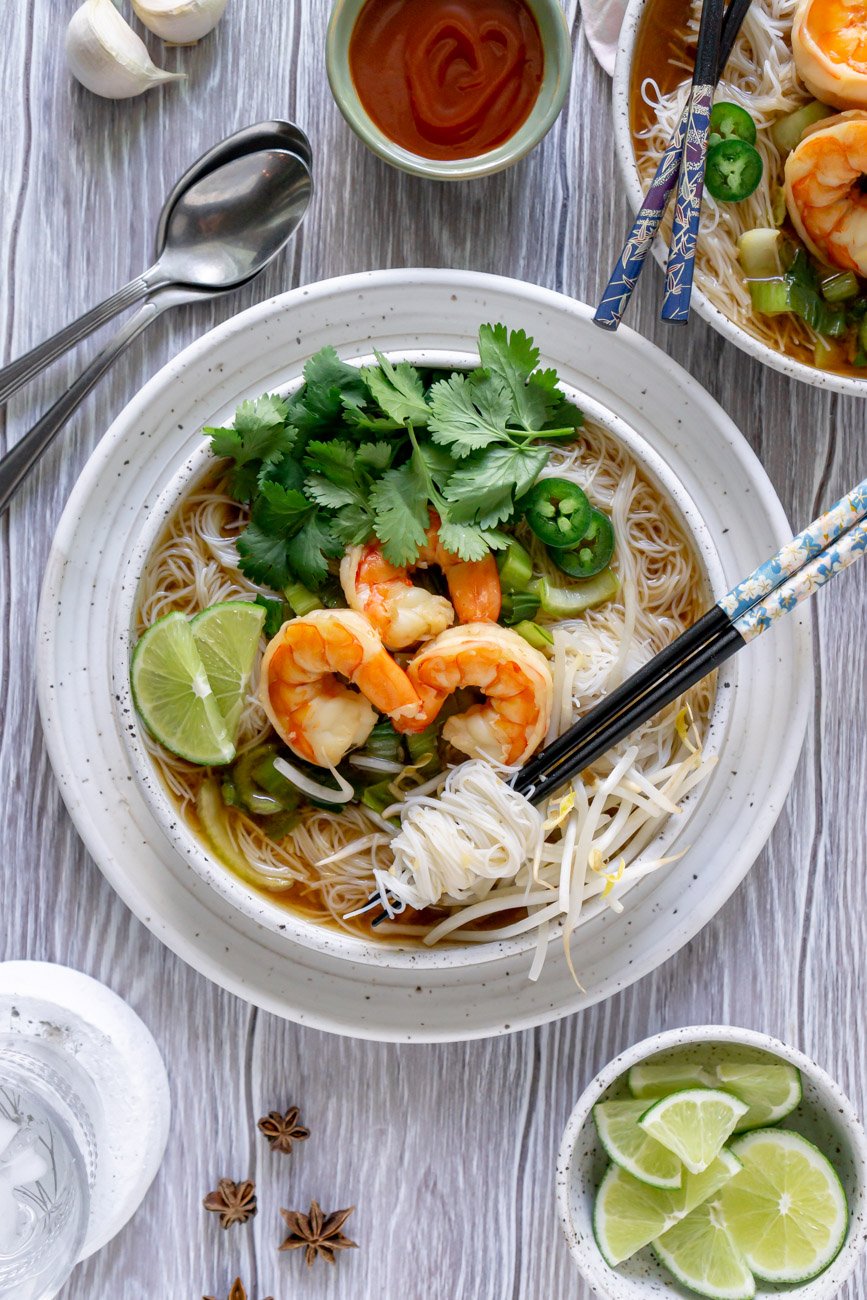
More Asian-Inspired Recipes
- Sesame Garlic Baby Bok Choy
- Asian Cucumber Salad
- Miso Glazed Chilean Sea Bass
- Egg Roll in a Bowl
- Citrus Soy Asian Salmon
- Maple Miso Mushroom Rice Bowls
If you tried this shrimp pho or any other recipe on my blog please leave a 🌟 star rating and tell me how it went in the 📝 comments below. I love hearing from you, and this helps my business thrive so I can continue providing free recipes!
Save this Recipe!
Enter your email & I’ll send it straight to your inbox.
Seafood Pho Noodle Soup
 Save this Recipe!
Save this Recipe!
Enter your email and I’ll send it directly to you.
Ingredients
Pho Broth Ingredients
- 1/2 tablespoon sesame oil
- 3 star anise
- 2 garlic cloves, minced
- 1 teaspoon grated ginger, or ginger paste
- 6 cups chicken broth, or vegetable broth
- 3 tablespoons low sodium soy sauce
- 3 tablespoons hoisin sauce
- 1 teaspoon fish sauce
- 1 lime, juice
- 1 jalapeño pepper, seeds removed and sliced
Pho Soup Ingredients
- 8 ounces thin rice noodles
- 10 jumbo shrimp, shells removed and set aside
- 2-3 heads of bok choy, chopped
- optional toppings: bean sprouts, cilantro, Thai basil, lime wedges, jalapeños, sriracha
Instructions
- Remove the shells from the shrimp and set aside.
- Heat the sesame oil in a large pot set over medium heat. Add the star anise, garlic, and ginger; heat until fragrant, about 30-60 seconds. Pour in the broth, shrimp shells, soy sauce, hoisin sauce, fish sauce, lime juice, and sliced jalapeño. Bring to a boil, then reduce the heat to low and simmer for 20 minutes with the pot covered 3/4 of the way.
- While the broth is simmering, cook the noodles according to package instructions. Drain in a strainer, then rinse the noodles with cold water until they are no longer warm to prevent them from continuing to cook. (I also recommend tossing the noodles with a drizzle of oil, like sesame oil, to prevent them from sticking.)
- Using a slotted spoon, carefully remove the shrimp shells and discard.
- Add the bok choy and shrimp to the broth and cook for 3-4 minutes, until the shrimp are fully cooked and opaque.
- Divide the noodles between bowls and ladle the soup over top, garnish and serve hot.
Notes
- Shrimp shells can also be wrapped in a cheese cloth for easy removal.
- Cooking rice noodles is similar to cooking pasta. First bring a large pot of water to a rolling boil. Place the noodles in the water and stir with a fork to prevent them from sticking.
- When the noodles are tender, remove from heat and drain. Then rinse immediately with cold water until the noodles have completely cooled.
- This stops the cooking process so the noodles don’t overcook. Don’t worry, the broth will heat the noodles back up!
- The amount of noodles you make will affect the cook time, so keep an eye on them.
- Here are some other options if you can’t find pho noodles:
- Pho: Pho noodles are one of the most well-known Vietnamese noodles. These noodles are flat, rather than string shaped. There are several different types of pho that are differentiated by the meat: (chicken), Pho Bo (beef), and Pho Xao (stirred pho).
- Bun (Rice Vermicelli): This is one of the most popular Vietnamese noodle types. They can be very thin or very thick and are often found in Bun Cha, Bun Thit Nuong, Bun Bo Hue, and Bun Rieu.
- Banh Canh: These noodles have a chewier texture, as they are made from a mixture of tapioca flour and rice flour. They are thick like udon noodles, but it’s important to note that udon noodles are made from wheat flour.
- Mi (Egg Noodles): Typically used in stir-fry, these noodles are pretty easy to find and affordable. They are a thin, yellow egg noodle that can be combined with various ingredients.
- Mien (Glass Noodles): Depending on where you are, these noodles might also be referred to as Chinese Bun. They are grey in color and opaque, with a chewy but slippery texture from the mixture of mung bean flour and tapioca flour in which they are made from. You might find these in soups or stir-fries
Nutrition
This post may contain affiliate links. Please read my privacy policy.

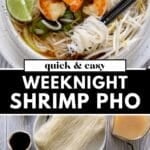
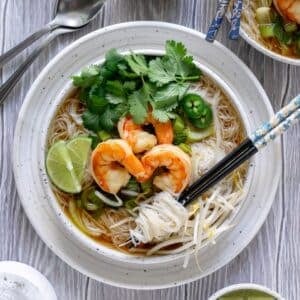
Made it this evening. Delicious. Will definitely make it again.